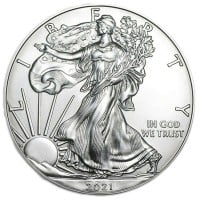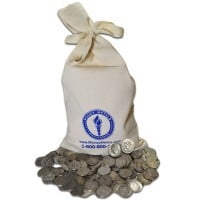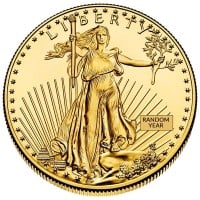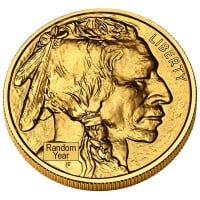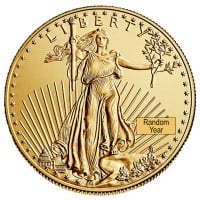US Mint: Interesting Facts from Its over 200 Years of Existence

The US Mint has been making the nation’s coins for more than 200 years. Congress established and funded the Mint shortly after the US won the Revolutionary War. In the years since, Mint officials have had to navigate the country’s momentous events. These include territorial expansion, wars, a Great Depression, and the transition from precious metals coinage to paper currency and clad coinage.
Officials have also been tasked with adapting to extraordinary changes in technology and equipment.
Here are some of the most interesting facts about the US Mint that cover 225 years of striking coins, medals, and… stuffing eagles?
United States Mint Silver Products:
US Mint – The First Federal Building
Congress adopted the Coinage Act on April 2, 1792. It established the United States dollar as the standard monetary unit and authorized the creation of the US Mint. The Act also provided federal funding for construction of the Mint’s first location in Philadelphia, Pennsylvania. The Mint became the first federally owned building to be newly constructed. The newly inked constitution imposed strict limits on the real property that could be owned by the federal government and minting facilities were one of the permitted types.
Fort Knox Doesn’t Have a Mint
Contrary to popular belief, none of the US coins have ever been struck at Fort Knox. It is true the facility in Fort Knox, Kentucky is affiliated with the US Mint. It is home to the US Bullion Depository which is used just for storing the gold and silver bullion reserves from the US as well as other countries.
Officially speaking, these reserves are rarely touched. The thousands of tons of gold kept there are not for use in today’s minting operations. They are intended to be a form of national savings. It is worth noting the controversy over these reserves. There has been no official audit of the holdings there since the 1950s and there is some reason to question whether all the metal remains in the vaults at Fort Knox.
The US Mint must acquire the precious metal used in the production of its coins elsewhere. By law, officials must buy only gold and silver bullion coins and bars mined within the US.
7 Mint Marks for 8 Mint Locations
The US Mint has had facilities in eight different locations over its 200+ years of operation. Philadelphia was the first and most recognizable location. It has been operating since 1792. By custom each mint location imprints a mintmark as a reference to which facility produced the coin. There are some exceptions. The major one being coins produced in Philadelphia which often carry no mint mark.
In many cases, the mint mark was a single letter which matched the first letter in the city where the Mint was located. One notable exception to this practice involves two mint cities which share the same first letter. The US operated a mint in Charlotte, North Carolina between 1838 and 1861, and used the C mintmark. The mint in Carson City, Nevada struck both gold and silver coins between 1870 and 1893 used the double letter mintmark ‘CC.’ This is the only time a mintmark has been composed of two letters.
The “D” mintmark also has a bit of interesting history. The letter D was used for the Dahlonega, Georgia Mint which operated between 1838 and 1861 and struck only gold US coins. The “D” mint mark was picked up by another facility in 1906 when the mint in Denver, Colorado began using it. Presses there have been stamping coins that way ever since.
People must distinguish between coins minted in Dahlonega and Denver by looking at the date. Anything struck before 1906 which bears the “D” mintmark was made in Georgia.
The “O” mintmark is also a bit of an exception. It represents the facility in New Orleans, Louisiana between 1838 and 1861 and again between 1879 and 1909.
The Abandoned Mint
The Mint might have had a third facility producing coins with a “D” mint mark. A new location in the The Dalles, Oregon was approved, but plans changed 6 years later. In 1870 construction was stopped midway through and no coins were ever struck. Interestingly, the building still stands.
Horsepower before Steam Power
In recent years the US Mint has been producing more than 28 billion coins annually – nearly all of them clad base metal coins for use in circulation. Of course, the US Mint lacked this production capability during its early existence.
Before the industrial revolution and the introduction of steam-powered coin presses, the mint relied on animal-powered presses. Horses and oxen were the ‘engines’ that drove coin production.
A Nickel is Worth More than a Dime?
The transition away from using gold and silver in US coins has led to some strange dilemmas. For example, today the US Mint spends more to produce 5-cent nickels than to make 10-cent dimes. Prior the 1965, the dime contained 90% silver. That precious metals content made the dime more costly to produce than the nickel.
Nowadays, the dime is made primarily of copper, while the 5-cent coin continues to be made from nickel. The value of the metal content was recently estimated at 11.18 cents as opposed to a cost of just 5.65 cents for the smaller dime. The Mint absorbs a loss on every nickel it strikes and it is likely only a matter of time before the Mint starts using a lower cost base metal, or abandons that coin altogether.
The Bald Eagle
The Bald Eagle is a national symbol in the US and it has adorned many coins over the years. The mighty bird signifies freedom and strength. It isn’t all serious business, however.
The Philadelphia Mint keeps a 150-year-old stuffed bald eagle. The bird once made a home on the mint’s premises, so it was adopted as a mascot. Officials had the bird stuffed after it died. Today it is on display for workers to remember and visitors to see.
Independent Beginnings
Despite the fact that the US Mint in Philadelphia was the first federal building, for more than half a century it operated as a largely independent agency which answered only to the President of the United States. In 1873, the mint was assimilated into the US Department of the Treasury. That agency still supervises it to this day.
Philadelphia’s Mints
There have been no fewer than four different minting facilities located in Philadelphia since 1792. The first one ran until 1833 before operations were moved to a larger location, once referred to as ‘The Grecian Temple.’
The Community College of Philadelphia was once the third location of the US Mint in Philadelphia. It operated there until 1969 when it was moved to its current location. The building used to house operations was the largest mint facility in the world in terms of size and production capacity.
It Does More than Just Coins
The US Mint is also responsible for designing and striking the Congressional Gold Medals. These medals don’t have a standard design as each one serves a different purpose. The bronze versions of these medals are also struck by the US Mint and sold to the public.
No Other Mint Strikes More
The US Mint is the largest producer of coins and medals in the world. The Mint is responsible for the manufacturing of US coins, of course, but that is not all it does. Few are aware, but the US Mint also strikes coins for other countries as well.




